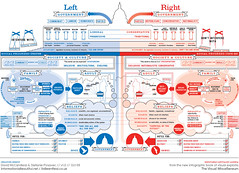Jane Hamsher wrote about the 11 Dimensional Chess approach to health care legislation that the Obama administration tried. That sent me back to some earlier thoughts I had shared about how we visualize the political spectrum. The simplest way to view things is one dimensional. Like the opening image here it breaks down into a right/left, red/blue, conservative/liberal, Republican/Democrat, or another single-axis spectrum. Many people recognize how inadequate such a simplified view is and various people (including myself) have sought to devise two-dimensional representations of the political landscape.
Of the many maps out there I think the easiest to comprehend is this from the Worlds Smallest Political Quiz:

With an axis measuring personal freedom issues and an axis measuring economic freedom issues it is not difficult to grasp the lay of the land according to this graph. Unfortunately this two dimensional representation, like all other two-dimensional representations, falls short of accurately describing reality.
I don’t know how many distinct axis may usefully divide the political landscape to understand the many varied perspectives that play into our national political debate but I have identified at least one more axis besides the personal and economic freedom axis – there is the power axis that deserves to be considered. How much political power a person has seems to have a distinct influence on their political outlook. Unlike the personal and economic outlook axis, which are virtually independent of each other, the power axis tends to insert some biases into people. The more political power a person attains the more likely they are to gravitate towards some degree of Big Government statism. I’m not sure which is the cause and which is the effect (I suspect they are simply intertwined) but there definitely seems to be a correlation between rising power and rising acceptance of statism. (I wish I could come up with a visual representation for this.)
While it is important for us to recognize that third dimension, perhaps another important insight can be gained from simply accepting the existence of any new axis – our perspective can be deceptive as to the view of others. From whatever your vantage point in the political universe your understanding of other viewpoints will be greatly enhanced anytime you are able to acquire a description of the other viewpoint from a vantage point that is not substantially the same as your own. Without that different perspective your view is reduced to two dimensions or less and you may fail to discern where others differ in their perspectives, or you may fail to recognize the significance when two people (perhaps as different as Ms. Hamsher and myself) agree on a particular point.

Leave a Reply